St Aldhelm's Chapel: A Clifftop Mystery
DORSET, ENGLANDST ALDHELM'S CHAPEL
9/26/20235 min read
A pirate or devil, I suppose they are much the same, and a saint guard the coast between them. Tonight the saint wins. The snow has hardened treacherously, and no one will be near Old Harry Rocks until the thaw. But the hardy and faithful among us have squeezed into Saint Aldhelm's chapel for the Christmas Eve service...

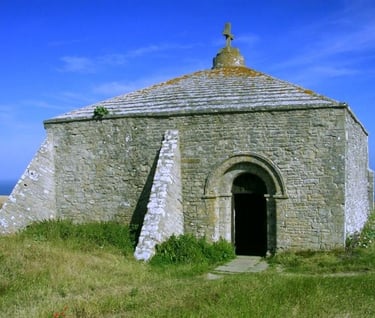

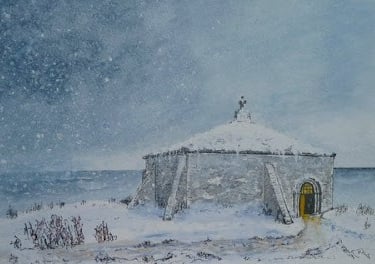
I have already written about the legends of Old Harry Rocks, but another iconic landmark that is a supernatural anchor in my novel, A Dorset Summer, is St Aldhelm's Chapel, nestled up on the clifftops at Saint Aldhelm's Head. It is also known as St Alban's chapel/St Alban's head, the Devil's Chapel, and as a Wishing Chapel.
There is considerable mystery surrounding the chapel - and this post is indebted to The Dorset Rambler (see link below) for pulling together the information I remember, but in a more cohesive manner! First, it is set on a circular earthwork, an ancient construction used at least as far back as the iron age (the impressive Maiden Castle earthworks is also in this part of the country - and I can attest that's worth a visit as well). It's Norman in construction, though some say the entranceway is Saxon. Secondly it is not built in a traditional church format: it is not in an east-west orientation, has no obvious place for an altar, and has a huge pillar in the middle of its tiny, square interior, not ideal for a congregation.
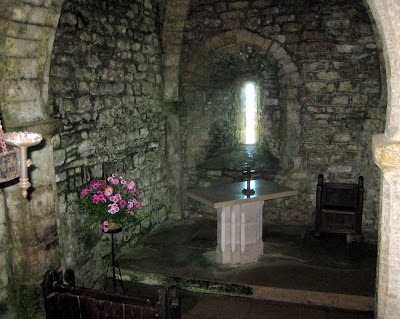

Photo credit: By Huligan0 - Own work, CC BY-SA 3.0, https://commons.wikimedia.org/w/index.php?curid=11929961
As to its names: Saint Aldhelm was a 7th century monk who became Abbot of Malmesbury Abbey and then the first bishop of Sherbourne. Aldhelm was a scholar and, apparently, a pretty good entertainer. He is known most famously for a set of riddles he sent to the King of Northumbria. Perhaps this is why he was also roped in to help with the biggest riddle in 7th century Britain - the controversy between the Celtic and Roman church over whose practice should reign supreme in this isle. (Historian that I am, I still feel upset about the Synod of Whitby.)
I'm guessing that the St. Alban appellation is either a common mis-repetition of the lesser-known name Aldhelm, or that the promontory and chapel were renamed for a more local saint. (Saint Alban is considered to be Britain's first Christian martyr.)
But back to the chapel that was (probably!) named after Aldhelm. Nothing is really known of its function as a religious building in its early centuries, apart from records of a priest here in the 13th century. Some surmise that it was actually built as a chantry, a small religious building where a priest was paid to pray for the souls of the dead (heavenly insurance for the wealthy). The religious connections are strengthened by the discovery in the 1950s of a thirteenth-century grave of a middle-aged woman found on the site, leading to speculation she was an anchoress. An anchorite is a person who chooses to give their life completely to contemplation and prayer, shut up in a tiny cell until death. Except, they became holy celebrities and people constantly sought them out for advice, so there wasn't always a bunch of time for meditation. Perhaps that is why this anchoress chose a remote home! Evidence of a smaller building nearby lends credence to the anchoress story. Since I am also very interested in Britain's most famous anchoress, Julian of Norwich, I like that theory. (I think maybe there's a novel in that!).
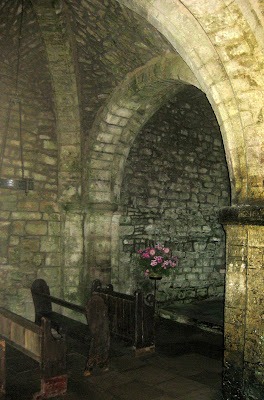

Photo credit: By Huligan0 - Own work, CC BY-SA 3.0, https://commons.wikimedia.org/w/index.php?curid=11929982
If not a chapel, some have suggested that it was a type of lookout - for the navigation of ships at sea (there's a mention of it as a sea mark) or to protect Corfe Castle further inland (it shares some similarities in construction with Corfe Castle). This idea is supported by evidence that a beacon may have sat on the roof where there is now a cross. Yet it has only one, tiny window.
I suspect it was all these and more, an ancient multi-purpose building: chantry, chapel and lookout!
As for its other names, I have not found any speculation for the name Devil's Chapel - maybe that is in keeping with the tradition of naming remote or odd formations after Old Nick (see my blog on Old Harry Rock). Or perhaps that's because it's a devil of a job to get to it! But it was definitely regarded as some sort of wishing chapel, because there is a hole in the central pillar where girls have dropped votive items such as hairpins, presumably after praying for a husband. By the way, you can also read centuries-old graffiti on the pillar.
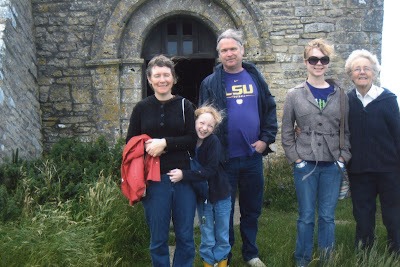

A windswept visit from many years ago!
The chapel was part of the Encombe estate for centuries, until they handed it over to the Worth Matravers parish council in the 1960s. Even if we are not sure about how it was originally used as a religious building, in more recent history (19th century) it was restored as a chapel for the families of the coastguards who had cottages nearby. When they moved, the chapel was abandoned again. As far as I know there are still services held in the chapel at Easter and in the summer - here is a link to the parish website.
There's a quick route and a more challenging route to get to the chapel. If you have limited time or mobility (or small children in tow, which is both), you can drive to a small car park at Renscombe Farm, from where it is a short walk.
The longer way could be undertaken as a mini-pilgrimage, by picking up the South West Coast Path in the area. If you begin near Chapman's Pool, you can include a penitential thigh workout in the climb down (184 steps) and up (219 steps) to the chapel. I admit it's been a long time since I have taken that route.
Well, that was a long post - and I didn't even exhaust all the stories. There are more than would fit into the tiny chapel! Take a visit, drink in the atmosphere, and decide for yourself.
Here is the excellent Dorset Rambler article on the chapel.
Here's a circular walk along the South West coastal path, taking in other landmarks such as Chapman's Pool - it starts near the chapel for the short walk I mentioned above.
Here's another, longer one beginning at Worth Matravers. They suggest refreshments at the Worth Matravers tea room. Don't start with tea there - trust me, you might not get any further!
